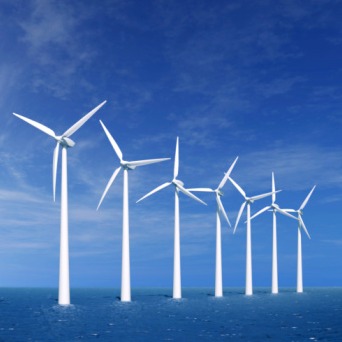 The DOE provided a major boost for the fledgling offshore wind industry by announcing grants for seven U.S. offshore wind projects to ensure commercial operation in state and federal waters by 2017.
The DOE provided a major boost for the fledgling offshore wind industry by announcing grants for seven U.S. offshore wind projects to ensure commercial operation in state and federal waters by 2017.
The projects will receive up to $4 million to complete the engineering, design and permitting phase of this award. The DOE will select up to three of these projects for follow-on phases that focus on siting, construction and installation and aim to achieve commercial operation by 2017. These projects will receive up to $47 million over four years, subject to Congressional appropriations, according to the DOE.
- Baryonyx Corp., based in Austin, Texas, plans to install three 6 MW direct-drive wind turbines in state waters near Port Isabel, Texas. The project will demonstrate an advanced jacket foundation design and integrate lessons learned from the oil and gas sector on hurricane-resistant facility design, installation procedures and personnel safety.
- Fishermen's Atlantic City Windfarm plans to install up to six direct-drive turbines in state waters three miles off the coast of Atlantic City, N.J. The project will result in an advanced bottom-mounted foundation design and innovative installation procedures to mitigate potential environmental impacts. The company expects this project to achieve commercial operation by 2015.
- Lake Erie Development Corporation (LEEDCo), a regional public-private partnership based in Cleveland, Ohio, plans to install nine 3 MW direct-drive wind turbines on ‘ice breaker’ monopile foundations designed to reduce ice loading. The project will be installed on Lake Erie, seven miles off the coast of Cleveland. Additionally, LEEDCo's private partners committed an additional $1 million in cost share as part of the agreement.
- Seattle, Wash.-based Principle Power plans to install five semi-submersible floating foundations outfitted with 6 MW direct-drive offshore wind turbines. The project will be sited in deep water 10 to 15 miles from Coos Bay, Ore. Principle Power's semi-submersible foundations will be assembled near the project site in Oregon, helping to reduce installation costs.
- Statoil North America of Stamford, Conn. plans to deploy four 3 MW wind turbines on floating spar buoy structures in the Gulf of Maine off Boothbay Harbor at a water depth of approximately 460 feet. These spar buoys will be assembled in harbor to reduce installation costs and then towed to the installation site to access the Gulf of Maine's extensive deep water offshore wind resources.
- The University of Maine, based in Orono, plans to install a pilot floating offshore wind farm with two 6 MW direct-drive turbines on concrete semi-submersible foundations near Monhegan Island. These concrete foundations could result in improvements in commercial-scale production and provide offshore wind projects with a cost-effective alternative to traditional steel foundations.
- Dominion Virginia Power of Richmond plans to design, develop, and install two 6 MW direct-drive turbines off the coast of Virginia Beach on innovative ‘twisted jacket’ foundations that offer the strength of traditional jacket or space-frame structures but use substantially less steel.
The DOE says its investment will help speed the deployment of stronger, more efficient offshore wind power technologies and showcase innovative technologies – helping to further lower costs and drive greater performance.
These projects will also help clear hurdles to installing utility-scale turbines in U.S. waters, connecting to the power grid and navigating new siting and permitting processes. Additionally, the DOE says it will work with each project to test these innovations in real offshore environments and conduct comprehensive instrumentation and data analysis that will help accelerate future U.S. offshore wind deployment.
While the news was encouraging, it was not unexpected as many industry observers – not to mention developers – have been awaiting the results since the summer.
The DOE says the offshore wind projects will accelerate the deployment of breakthrough wind power technologies that will help diversify the nation's energy portfolio, promote economic development and launch the U.S. offshore wind industry.
While the news does not figure to affect the status of first-generation project developers, such as Cape Wind and Deepwater Wind, the DOE's funding commitment ‘spurs action faster than otherwise would have occurred,’ notes Jim Lanard, executive director of the Offshore Wind Development Coalition. ‘This is very significant. It is a shot in the arm for the offshore wind industry because the selected projects are required to get steel in the water within the next few years.’
Following the announcement, several of the DOE recipients laid out the next steps in their respective development plans.
Fishermen's Energy, which has all federal and state permits necessary for construction, says it will focus on selecting a contractor for the project, with an emphasis on New Jersey vendors. Construction in Atlantic City is planned to commence onshore in 2013 with offshore construction and commissioning by 2014 – which would make it the first grid-connected U.S. offshore wind farm.
For its part, Baryonyx says the Gulf Offshore Wind (GO-Wind) project, slated for the Gulf of Mexico off coastal Texas, will initiate the environmental assessment studies under the supervision of the U.S. Army Corps of Engineers (USACE).
"The public consultation process for the project was recently completed by the USACE,’ says Ian Hatton, Baryonyx CEO. ‘Constructive feedback from many interested organizations and individuals was received, and this information will be used to shape the assessment studies needed before a decision to install the GO-Wind demonstration project can be made.’



